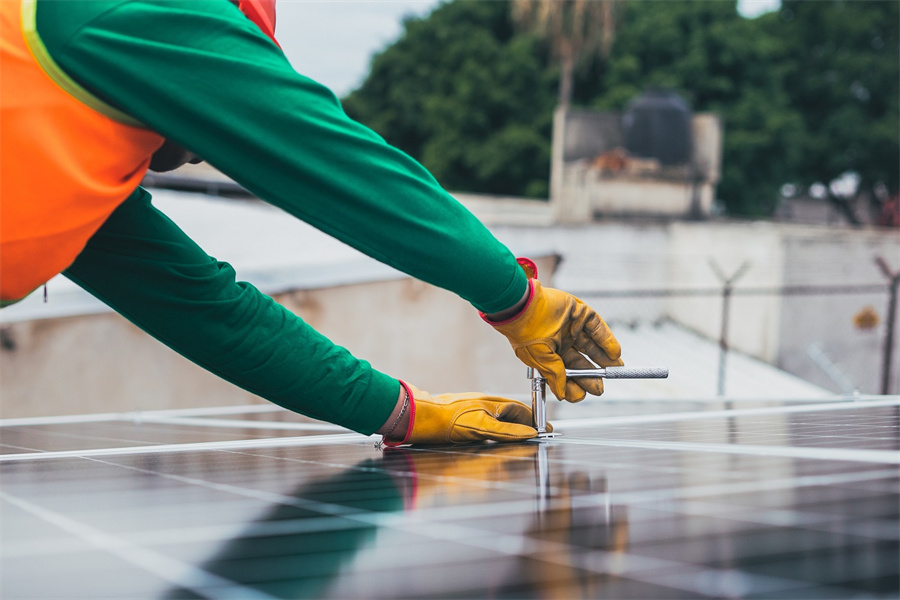Supply and demand analysis and price forecast of photovoltaic industry chain in the second half of 2023
time:2023-07-27 10:22:58 Views:0 author:Jinan Freakin Power Ltd.
01 Silicon material: Entering a stable period, the differentiation of N-type and P-type products intensifies
1. Situation of silicon material supply
Situation of polysilicon material supply:
From January to June this year, the cumulative production of polysilicon was about 655,000 tons (283GW), accounting for 73% of last year's annual supply (900,000 tons). In the second half of the year, Jingnuo, Dongli, Baofeng, Shangji and other enterprises will start production one after another. It is expected that the production capacity will exceed 2 million tons by the end of the year. The actual global production this year is expected to reach about 1.5 million tons. According to the capacity planning, the production of silicon materials will continue to increase in the second half of the year.
Terminal demand status: The terminal demand in May and June was lower than expected, resulting in the continuous accumulation of silicon material inventory, and the price of silicon material dropped sharply to the cost price or even lower.
Difficulties for new entrants to the market: Some new entrants to the polysilicon market are facing difficulties. They are facing price pressures before making profits. There are rumors that some new polysilicon manufacturers plan to delay production. Some old production capacity even chose to stop production for maintenance, and the prosperity of the polysilicon industry has become a thing of the past. In the future, the silicon material market will enter a difficult period, and the competition will mainly focus on quality, cost and strength.
Silicon material supply in July: It is estimated that the output of silicon material in July will reach 135,000 tons (equivalent to 58GW+), an increase of about 8% month-on-month.
P-type silicon material is still the main product of most manufacturers and new entrants, and the supply is sufficient. N-type silicon materials are currently mainly produced by three leading enterprises, with relatively limited output, and the cost is about 8-10 yuan/kg higher than that of P-type silicon materials. At present, the overall N-type silicon production capacity accounts for between 20% and 30%. With the rapid release of TOPCON production capacity, the silicon material factory will continue to increase N-type production through technological improvement.
From the perspective of the overall supply situation, the monthly actual output still maintains a growth trend. Through the recent inventory clearance action of a large number of low-price orders, the inventory transfer and pressure of large polysilicon manufacturers have dropped sharply, especially N-type polysilicon is facing pressure from crystal pullers. Purchasing competition and tight supply situation. However, the overall silicon material inventory of "silicon material plant + crystal pulling plant" is expected to remain above 100,000 tons, and the supply is still sufficient relative to the installed capacity demand.
2. Demand status of silicon materials
Recently, the price of silicon materials has unexpectedly continued to fall to the cost line of some enterprises.
Some leading crystal pullers began to sign a large number of orders at low prices, even 10,000-ton orders. N-type materials have gradually become the choice for crystal pullers to reserve resources in the medium term. Some large manufacturers have signed long-term contracts at low prices to lock in N-type silicon materials. From the perspective of inventory digestion, the short-term high operating rate of the crystal pulling process cannot quickly digest the large amount of silicon material in stock. This part of the silicon material will replace the crystal puller’s purchase orders in July. However, there will still be a large amount of silicon material output in July, and the inventory of silicon material manufacturers is still facing the risk of slow growth.
From the perspective of demand type, with the release of a large amount of TOPCON production capacity in the third and fourth quarters, crystal pullers have a strong willingness to purchase N-type silicon materials. Most of the N-type materials have been monopolized by leading crystal pullers, and because the production capacity of PERC cells has not increased, the demand for P-type materials is not optimistic.
3. Price situation of silicon materials
At present, the main transaction prices of large manufacturers of dense materials have dropped to about 60-65 yuan/kg, and the premium of N-type materials is about 10 yuan/kg.
In July, after a large number of low-price warehouse clearances, large polysilicon manufacturers are more willing to raise prices, while under the circumstances of large-scale manufacturers’ bottom-hunting and long-term contract monopoly, small crystal pullers may face the problem of tight supply of N-type materials and a slight increase in prices , the supply of P-type materials still seriously exceeds the demand, and the price still has room for a slight decline. The supply and price of N and P-type silicon materials are polarized.
Judging from the long-term trend from the second half of the year to next year, the demand for N-type silicon materials may exceed expectations. For small manufacturers and new silicon material manufacturers, N-type materials are still a relatively difficult threshold, but there are also opportunities for reversal. P-type materials will face a situation of continuously falling demand and prices.
02 Silicon wafers: Low prices support increased production, and the risk of inventory accumulation increases
1. Silicon wafer supply status
The current inventory of silicon wafers is about 1 billion pieces.
In July, the release of low-priced silicon materials in stock and the commissioning of new production capacity by individual companies supported the continued increase in silicon wafer production. Although power restrictions in Inner Mongolia have affected about 300 million pieces of production capacity, the total output in July is still expected to reach about 57GW, an increase of about 8% month-on-month.
In terms of size, the silicon wafer industry officially announced the cancellation of the 166 size quotation, and the 166 era has completely ended; recently, 9 leading companies discussed the ultimate size of the module, and determined that the size of 182*192 or 182*210 may become the future N-type The standard configuration of battery capacity; however, the existing 182P type capacity is also beginning to seek better differentiated sizes to enhance the competitiveness of enterprises, such as adopting 182 size or changing to 183.75 or other rectangular sizes; while the customer base of 210 size is relatively large Small and fixed.
In terms of types, more and more crystal pullers are aware of the demand growth potential brought about by the release of TOPCON battery capacity. Many crystal pullers have begun to increase production of N-type silicon wafers, and even traders are willing to buy at low prices.
2. Demand status of silicon wafers
In July, the downstream N-type production capacity will continue to be released, and the new cell production capacity put into production from January to April will gradually enter the stage of large-scale production, and the demand for N-type silicon wafers will continue to increase. About 11GW per month; while P-type silicon wafers are still facing the consumption of existing PERC production capacity, and the demand has not increased.
3. Silicon wafer price situation
At present, the price of mainstream high-efficiency P-type 182 batteries is about 2.7 yuan/piece, and the price of P-type 210 batteries is about 3.7 yuan/piece. Although there is still some inventory of silicon wafers, under the influence of close to the cost line and the expected upward trend in the future, the decline of silicon wafers has narrowed and stabilized in stages. However, judging from the current production schedule, the supply and demand pattern of silicon wafers has not changed substantially. It is expected that with the gradual increase in crystal pulling capacity, silicon wafers will still face the risk of accumulating inventory, and prices may still be under pressure. Against the background of huge production capacity and limited battery consumption, it is difficult to change the supply and demand pattern due to temporary power cuts, and it is relatively difficult to reverse the price.
Overall, the polysilicon and wafer markets are facing some challenges in terms of supply, demand and pricing. The supply of silicon materials is relatively sufficient, but new entrants and some enterprises may face price pressures. In terms of demand, the demand for N-type silicon materials has a greater growth potential, while the demand for P-type materials is relatively weak. The silicon wafer market is affected by inventory accumulation and changes in demand structure, and the price has fallen to a certain extent, but the overall trend is relatively stable.
03 Cells: Inventory pressure is relatively small, production is limited
1. Battery supply status
At present, the cell production capacity is still in full operation, and the output in July is expected to be close to 51GW, an increase of about 3% from the previous month. Inventory levels are relatively normal at the moment.
The change in production capacity is mainly due to the gradual advancement of the newly added TOPCON production capacity. The size of P-type cells tends to increase, such as 182+0.3, 183.75, 182*192 and other sizes. So far, TOPCON production capacity has been put into operation this year with an effective production capacity of more than 190GW. The third quarter will be the stage for the concentrated release of TOPCON production capacity and the landing of new production capacity, and the supply of TOPCON will increase month by month.
2. Demand status of cells
Recently, the decline in battery prices has narrowed and there are signs of stabilization. After a one-month wait-and-see period, some component manufacturers began to increase their purchases of batteries.
Overall, the demand for cells is good, and the shipments are relatively smooth. The inventory of the cell segment is low, and the production capacity is limited. With the stabilization of upstream prices and the increase of purchases by downstream module manufacturers, cell quotations are likely to rise.
3. Cell price status
At present, the price of mainstream high-efficiency P-type 182 batteries is maintained at between 0.71-0.72 yuan per watt, with a slight increase. The price of N-type TOPCON battery is about 0.79 yuan per watt, and the price of 210 battery is about 0.74 yuan per watt. Although near the bottom range, some downstream module manufacturers increased their willingness to purchase, which supported a slight rebound in the price of 182 high-efficiency batteries, but the current overall demand is still unclear, and battery manufacturers still need to further negotiate with downstream module manufacturers, so there is room for price rebound limited. As downstream component manufacturers begin to stock up in large quantities and increase operating rates, there is still room for batteries to rebound.
04 Component industry: terminal demand is unclear, and production scheduling is cautious
Recently, module quotations are still chaotic. The quotations of monocrystalline P-type mainstream power are mainly in the range of 1.3-1.38 yuan/watt, and the decline of module prices has narrowed and tended to be stable. Involutional competition among domestic module manufacturers is intensifying.
At present, the spot price of modules has reached a staged bottom, which is in line with the revenue expectations of power stations, but the terminal demand and the operating rate of modules have not yet reached the expected outbreak.
We need to pay attention to a question, that is, in the stage of continuing to wait and see in the terminal market, the European module inventory experienced a sharp depreciation in June, has it been fully absorbed? In June, the operating rate of module manufacturers did not decrease substantially, and domestic projects were also delayed. Is the domestic inventory shipment normal? These factors may be important factors affecting the uncertain production schedule of the module industry in July.
Of course, some projects have been gradually launched in the domestic terminal market recently, and the demand for projects in overseas markets such as South America has also shown signs of improvement. We believe that with the stabilization of prices in the industry chain, it is only a matter of time before the peak season arrives. It may be just a stage of gaining momentum at present, and there may be greater growth in the future. A turning point may come later or in August.
05 Summary
At present, the price decline of silicon materials, silicon wafers and cells has narrowed and stabilized. The component industry is still adjusting prices. In the short term, prices will stabilize and terminal demand is expected to increase.
After the polysilicon industry has cleared its warehouses at low prices, large manufacturers intend to raise prices. The supply and price of N-type and P-type products have diverged. N-type materials may face supply shortages and price increases, while P-type materials are still in excess supply.
The silicon wafer industry is driven by the bottom-hunting behavior of large manufacturers, and the operating rate has rebounded. However, the risk of inventory accumulation has increased, and prices are still under pressure.
The output of the cell industry is limited, the inventory is low, and the pressure on shipments is small. As module prices stabilize and rise, cell prices are expected to rebound, but downstream demand is still unclear and needs to be observed.
Although the inventory of the module industry was less than expected under the wait-and-see mood in June, the price was not stable, and the outbreak of terminal demand may be delayed. However, with the rebound of upstream N-type silicon material prices and rising battery prices, the market atmosphere has been boosted, and the overall price may bottom out in advance, stimulating demand to explode in advance, and the peak season is expected to usher in late July or August.





